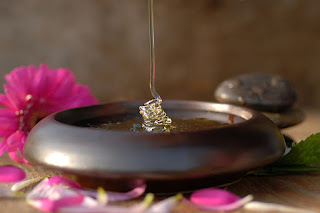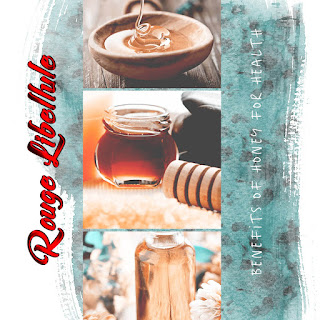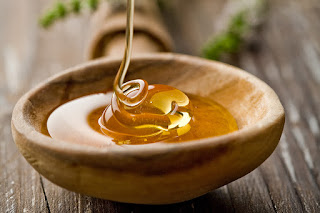Honey is made by bees from the nectar of flowers. It is basically used to sweeten foods. But it also has different virtues for health.
Sweetness and low calories
Rather than sweetening your tea or herbal tea, do you opt for the tablespoon of honey? Great good you because honey is adorned with virtues that do not offer sugar. Besides, what is the difference between a piece of sugar and a spoonful of honey?
White sugar as it is known is 99.9% sucrose . Sucrose is present in all chlorophyllous plants and is produced industrially from sugar cane and sugar beet . It consists of two molecules, fructose and glucose .
It is not a secret for anyone that honey is very rich in sugars, since it contains between 78% and 80%. Nevertheless, unlike sugar composed almost exclusively of sucrose, several carbohydrates, in different proportions, are found in honey:
A majority of fructose and glucose.
Maltose, sucrose and other polysaccharides in small proportions.
Moreover, it is the proportion between these different sugars which determines the consistency of honey: if it is richer in glucose, it crystallizes. On the other hand, if fructose prevails, it remains liquid.
It should also be known that the sweetening power of honey is greater than that of sugar. Translation: in equal quantities, your tea will taste sweeter with honey than with sugar! For example, 3 pieces of white sugar provide the same amount of carbohydrates as two sugar spoons of honey. In addition, it brings fewer calories. There is therefore no reason to hesitate!
On the other hand, with its high level of glucose, honey has a high hyperglycaemic power, diabetics must therefore limit their consumption and seek medical advice.
Finally, the honey is also composed of water, between 15% and 20% approximately, mineral salts and trace elements, lipids in small quantity, vitamins, B essentially, and many other complex organic compounds of which number of enzymes. So many good reasons to trade your white powder for brown liquid!
Sweetness and low calories
Rather than sweetening your tea or herbal tea, do you opt for the tablespoon of honey? Great good you because honey is adorned with virtues that do not offer sugar. Besides, what is the difference between a piece of sugar and a spoonful of honey?
White sugar as it is known is 99.9% sucrose . Sucrose is present in all chlorophyllous plants and is produced industrially from sugar cane and sugar beet . It consists of two molecules, fructose and glucose .
It is not a secret for anyone that honey is very rich in sugars, since it contains between 78% and 80%. Nevertheless, unlike sugar composed almost exclusively of sucrose, several carbohydrates, in different proportions, are found in honey:
A majority of fructose and glucose.
Maltose, sucrose and other polysaccharides in small proportions.
Moreover, it is the proportion between these different sugars which determines the consistency of honey: if it is richer in glucose, it crystallizes. On the other hand, if fructose prevails, it remains liquid.
It should also be known that the sweetening power of honey is greater than that of sugar. Translation: in equal quantities, your tea will taste sweeter with honey than with sugar! For example, 3 pieces of white sugar provide the same amount of carbohydrates as two sugar spoons of honey. In addition, it brings fewer calories. There is therefore no reason to hesitate!
On the other hand, with its high level of glucose, honey has a high hyperglycaemic power, diabetics must therefore limit their consumption and seek medical advice.
Finally, the honey is also composed of water, between 15% and 20% approximately, mineral salts and trace elements, lipids in small quantity, vitamins, B essentially, and many other complex organic compounds of which number of enzymes. So many good reasons to trade your white powder for brown liquid!
 |
| Honey, it brings fewer calories. |
Other apicultural products
Bees are real little woodcutters, they never stop (or almost) and all blindly serve their queen. Organized, hardworking, they do not idle ... for our greatest pleasure. Without detailing the many existing varieties of honey (chestnut, acacia, rayon, rosemary, etc.), be aware that our friends bees produce a multitude of products: royal jelly , propolis , pollen.
Pollen
Yes yes, the pollen that the foragers harvest to feed their congeners is edible. Not only can pollen feed men, but it is also very nutritious. For example, 100 grams of pollen equals 500 grams of beef! This is why it is particularly recommended to fight against physical and intellectual fatigue .
Propolis
It's a little dough to do everything in the hive. Basically, it is a resin produced by the buds of certain tree species. Transported to the hive, it is mixed with wax and becomes propolis, a kind of cement to repair any cracks. In addition, it is used by bees as an insulator and as a natural antibiotic . These same antimicrobial properties are used in medicine.
Royal jelly
Royal jelly is secreted by worker bees between the fifth and fourteenth day of their existence (workers who are then called nannies). Whitish substance with pearly reflections, gelatinous consistency, warm taste, acid and very sweet, it is used to feed the larvae of the colony until their third day and the queen once she left the royal cell.
It is composed of carbohydrates (mostly fructose and glucose), water and lipids. Rich in vitamin B5 and trace elements, royal jelly is known for its revitalizing, stimulating and euphoric properties.
Pollen
Yes yes, the pollen that the foragers harvest to feed their congeners is edible. Not only can pollen feed men, but it is also very nutritious. For example, 100 grams of pollen equals 500 grams of beef! This is why it is particularly recommended to fight against physical and intellectual fatigue .
Propolis
It's a little dough to do everything in the hive. Basically, it is a resin produced by the buds of certain tree species. Transported to the hive, it is mixed with wax and becomes propolis, a kind of cement to repair any cracks. In addition, it is used by bees as an insulator and as a natural antibiotic . These same antimicrobial properties are used in medicine.
Royal jelly
Royal jelly is secreted by worker bees between the fifth and fourteenth day of their existence (workers who are then called nannies). Whitish substance with pearly reflections, gelatinous consistency, warm taste, acid and very sweet, it is used to feed the larvae of the colony until their third day and the queen once she left the royal cell.
It is composed of carbohydrates (mostly fructose and glucose), water and lipids. Rich in vitamin B5 and trace elements, royal jelly is known for its revitalizing, stimulating and euphoric properties.
 |
| Honey has antiseptic and antibiotic properties. |
Medicinal properties
Among the innumerable therapeutic uses of honey, one of the main remains its antiseptic and antibiotic properties. Some characteristics of honey give it an important antibacterial power. Its viscosity , for example, limits the dissolution of oxygen, thus ensuring better tissue oxygenation. On the other hand, its low protein concentration prevents bacteria from growing properly.
Before the appearance of antibiotics, honey was often used in the medical world. For example, it was used as an antiseptic agent for the cure of infections and to gently treat warts, infection pimples and boils. During the First and Second World Wars, it was used to accelerate the healing of wounds of soldiers. Nevertheless, it should be noted that, for the moment, no scientific study has examined the antibacterial effect of honey.
It has also been widely used as a scarring and, finally, as a beauty product for Roman and Greek women who took baths with milk and honey to tone their faces. In addition, it should be noted that propolis is also an antibiotic, an antiseptic and a powerful fungicide and that, even the bees have understood! Indeed, they coat their hive to limit the growth of fungi and bacteria. Not crazy the bee!
Before the appearance of antibiotics, honey was often used in the medical world. For example, it was used as an antiseptic agent for the cure of infections and to gently treat warts, infection pimples and boils. During the First and Second World Wars, it was used to accelerate the healing of wounds of soldiers. Nevertheless, it should be noted that, for the moment, no scientific study has examined the antibacterial effect of honey.
It has also been widely used as a scarring and, finally, as a beauty product for Roman and Greek women who took baths with milk and honey to tone their faces. In addition, it should be noted that propolis is also an antibiotic, an antiseptic and a powerful fungicide and that, even the bees have understood! Indeed, they coat their hive to limit the growth of fungi and bacteria. Not crazy the bee!
Energy source
There are a multitude of honeys: acacia, heather, chestnut, eucalyptus, etc. with characteristics, colors, flavors ... and different properties.
But they obviously have things in common. Thus, the carbohydrates of honey are mostly fructose and glucose. What is the difference with sugar? And these carbohydrates are very easily assimilated by the cells of the body that can draw the fuel necessary for their operation. Indeed, among the various existing carbohydrates, not all are assimilated in the same way. Some may be composed of several glucose molecules, basic carbohydrate. For example, the basic white sugar is composed of sucrose but the cells can not use this carbohydrate, it must be broken down into a molecule of glucose and a molecule of fructose to be metabolized.
This process, even if it is not "slow" still takes some time. On the other hand, with honey, this problem does not exist since it mainly contains glucose and fructose that the cells can use directly. In ancient times, for example, athletes drank honeyed water to quickly recover their strength. Sugar apart, honey contains a multitude of trace elements that gives it virtues.
Other beekeeping products are not in question energy issue:
Pollen is also highly energetic: eating 100 grams is like eating 7 eggs!
Royal jelly allows the queen of a colony, which feeds exclusively, to live up to forty times longer than its congeners! Although this is not true in humans, the fact remains that the jelly, rich in protein and trace elements, is a great source of energy!
Sport
Composed of fructose and glucose, it is easily assimilated by the body, making it an interesting energy source for athletes.
Sore throat
It also helps with relief from angina or sore throat. A spoonful of honey in a hot drink soothes irritation.
It is customary to decorate a good tea with a tablespoon of honey to cure a nasty cold. Far from being a relic of obsolete customs, this gesture is on the contrary full of common sense! Indeed, it seems that honey reduces the adhesion of bacteria, preventing them from becoming fixed and proliferate. For example, honey helps to reduce sore throat and, in the case of dry coughs, to thin the mucus.
Also note the interest of pollen in the treatment of hay fever. And yes, it may seem paradoxical, but ultimately it is simply treating evil with evil, the very principle of homeopathy. Finally, we must remember that if honey can be a real plus in the treatment of colds, it is not enough in itself because it does not address the causes of the problem. If your symptoms persist, it is best to consult a doctor who will prescribe the appropriate treatment.
Antioxidant
Its antioxidant power comes from the flavonoids it contains - which are more present in honeys of dark color.
Healing
But it is especially its healing and antiseptic properties that interest most doctors. It would thus cure some wounds . Indeed, its low water content, its viscosity, its high sugar content, its low protein concentration and its level of acidity limit the growth of microbes , which explains its antibacterial power.
 |
| Honey was often used in the medical world. |
Constipation
In addition to providing energy, fighting bacteria and soothing sore throats, honey also acts on the digestive sphere! It has diuretic properties, laxatives and helps fight against temporary constipation . It would also be effective against infections of the stomach and intestines. As for pollen, it would be effective in treating colitis and constipation as well. Moreover, the possibility of preventing and treating certain minor gastrointestinal conditions such as inflammation or gastric ulcer by oral administration of honey is not excluded.
In addition to being good for your health, honey is good! With a yoghurt, a piece of foie gras or simply a good gingerbread, it is savored in many ways and pleases everyone. No reason to hesitate, dive into a jar of honey and enjoy all its benefits.
Medical Honey
Any honey, however, can not do the trick. A medical honey, and kept in good conditions (in the cool, protected from light, a year maximum), is necessary.
Advice
Despite its advantages, it must be remembered that honey is very sweet: be careful to brush your teeth after eating, to avoid the risk of cavities.
References:
Interesting Facts About Honey
Health benefits of honey




